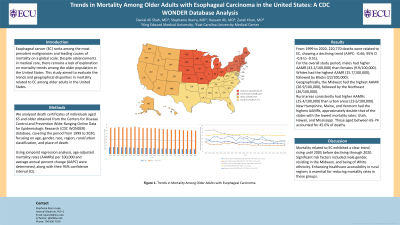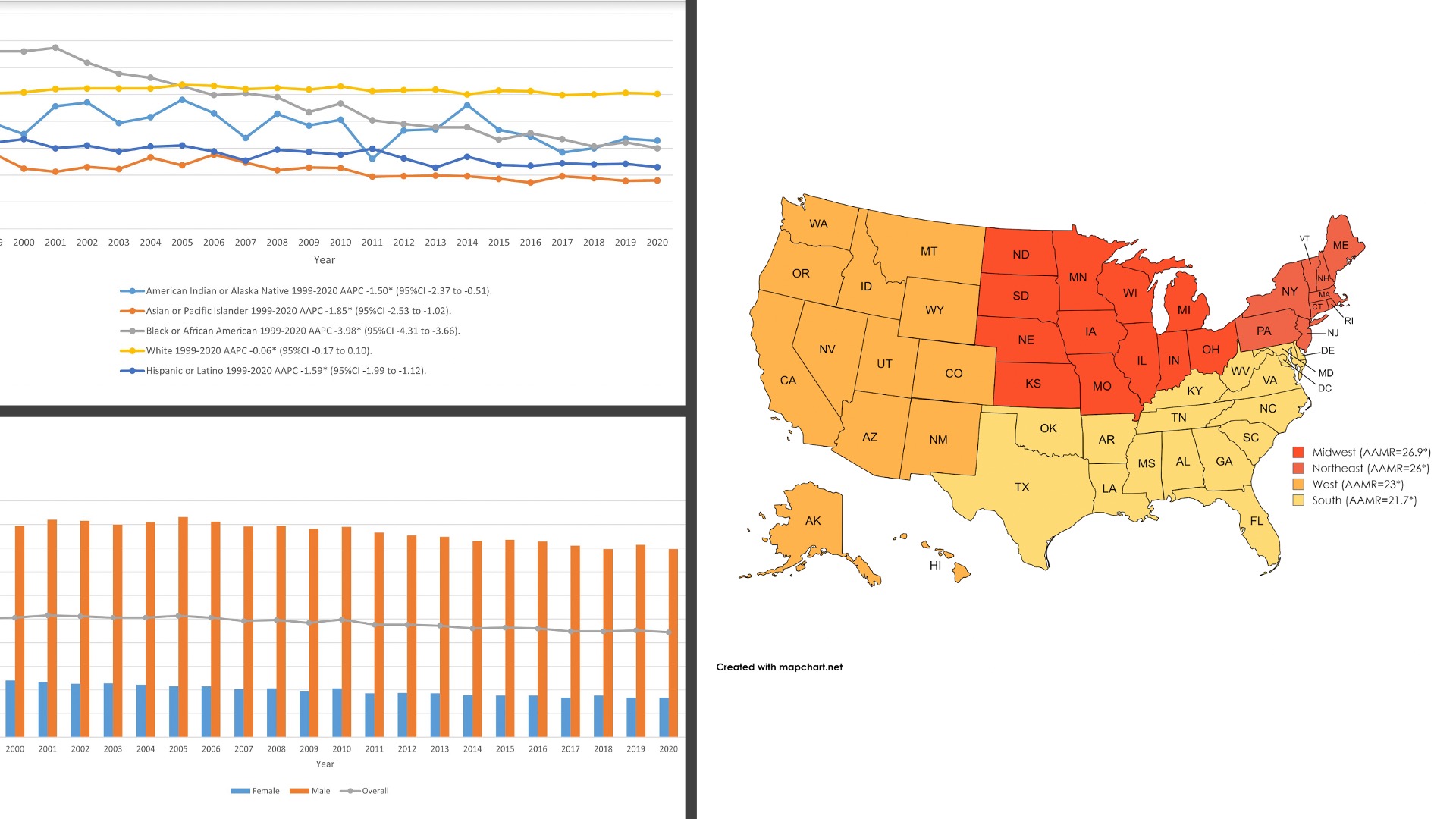Tuesday Poster Session
Category: Esophagus
P3933 - Trends in Mortality Among Older Adults with Esophageal Carcinoma in the United States: A CDC WONDER Database Analysis
Tuesday, October 29, 2024
10:30 AM - 4:00 PM ET
Location: Exhibit Hall E

Has Audio

Stephanie Ibarra, MD
East Carolina University Medical Center
Greenville, NC
Presenting Author(s)
M Danial Ali Shah, MD1, Stephanie Ibarra, MD2, Hassam Ali, MD3, Zarak H. Khan, MD2
1King Edward Medical University, Lahore, Punjab, Pakistan; 2East Carolina University, Greenville, NC; 3ECU Health Medical Center, Greenville, NC
Introduction: Esophageal cancer (EC) ranks among the most prevalent malignancies and leading causes of mortality on a global scale. Despite advancements in medical care, there remains a lack of exploration on mortality trends among the older population in the United States. This study aimed to evaluate the trends and geographical disparities in mortality related to EC among older adults in the United States.
Methods: We analyzed death certificates of individuals aged 65 and older obtained from the Centers for Disease Control and Prevention Wide-Ranging Online Data for Epidemiologic Research (CDC WONDER) database, covering the period from 1999 to 2020, focusing on age, gender, race, region, rural/urban classification, and place of death. Using joinpoint regression analysis, age-adjusted mortality rates (AAMRs) per 100,000 and average annual percent change (AAPC) were determined, along with their 95% confidence interval (CI).
Results: From 1999 to 2020, 220,770 deaths were related to EC, showing a declining trend (AAPC: -0.66; 95% CI -0.8 to -0.51). For the overall study period, males had higher AAMR (43.2/100,000) than females (9.9/100,000). Whites had the highest AAMR (25.7/100,000), followed by Blacks (22/100,000). Geographically, the Midwest had the highest AAMR (26.9/100,000), followed by the Northeast (26/100,000). Rural areas consistently had higher AAMRs (25.4/100,000) than urban areas (23.6/100,000). New Hampshire, Maine, and Vermont had the highest AAMRs, approximately double that of the states with the lowest mortality rates: Utah, Hawaii, and Mississippi. Those aged between 65-74 accounted for 45.6% of deaths.
Discussion: Mortality related to EC exhibited a clear trend, rising until 2005 before declining through 2020. Significant risk factors included male gender, residing in the Midwest, and being of White ethnicity. Enhancing healthcare accessibility in rural regions is essential for reducing mortality rates in these groups.

Disclosures:
M Danial Ali Shah, MD1, Stephanie Ibarra, MD2, Hassam Ali, MD3, Zarak H. Khan, MD2. P3933 - Trends in Mortality Among Older Adults with Esophageal Carcinoma in the United States: A CDC WONDER Database Analysis, ACG 2024 Annual Scientific Meeting Abstracts. Philadelphia, PA: American College of Gastroenterology.
1King Edward Medical University, Lahore, Punjab, Pakistan; 2East Carolina University, Greenville, NC; 3ECU Health Medical Center, Greenville, NC
Introduction: Esophageal cancer (EC) ranks among the most prevalent malignancies and leading causes of mortality on a global scale. Despite advancements in medical care, there remains a lack of exploration on mortality trends among the older population in the United States. This study aimed to evaluate the trends and geographical disparities in mortality related to EC among older adults in the United States.
Methods: We analyzed death certificates of individuals aged 65 and older obtained from the Centers for Disease Control and Prevention Wide-Ranging Online Data for Epidemiologic Research (CDC WONDER) database, covering the period from 1999 to 2020, focusing on age, gender, race, region, rural/urban classification, and place of death. Using joinpoint regression analysis, age-adjusted mortality rates (AAMRs) per 100,000 and average annual percent change (AAPC) were determined, along with their 95% confidence interval (CI).
Results: From 1999 to 2020, 220,770 deaths were related to EC, showing a declining trend (AAPC: -0.66; 95% CI -0.8 to -0.51). For the overall study period, males had higher AAMR (43.2/100,000) than females (9.9/100,000). Whites had the highest AAMR (25.7/100,000), followed by Blacks (22/100,000). Geographically, the Midwest had the highest AAMR (26.9/100,000), followed by the Northeast (26/100,000). Rural areas consistently had higher AAMRs (25.4/100,000) than urban areas (23.6/100,000). New Hampshire, Maine, and Vermont had the highest AAMRs, approximately double that of the states with the lowest mortality rates: Utah, Hawaii, and Mississippi. Those aged between 65-74 accounted for 45.6% of deaths.
Discussion: Mortality related to EC exhibited a clear trend, rising until 2005 before declining through 2020. Significant risk factors included male gender, residing in the Midwest, and being of White ethnicity. Enhancing healthcare accessibility in rural regions is essential for reducing mortality rates in these groups.

Figure: Trends in Mortality Among Older Adults with Esophageal Carcinoma
Disclosures:
M Danial Ali Shah indicated no relevant financial relationships.
Stephanie Ibarra indicated no relevant financial relationships.
Hassam Ali indicated no relevant financial relationships.
Zarak Khan indicated no relevant financial relationships.
M Danial Ali Shah, MD1, Stephanie Ibarra, MD2, Hassam Ali, MD3, Zarak H. Khan, MD2. P3933 - Trends in Mortality Among Older Adults with Esophageal Carcinoma in the United States: A CDC WONDER Database Analysis, ACG 2024 Annual Scientific Meeting Abstracts. Philadelphia, PA: American College of Gastroenterology.
